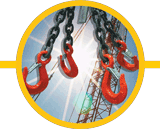Working Load Limits

Working Load Limits
Numerical values published for Breaking Strength and Working Load Limit are very specific in one point:
- They refer to straight, in-line pull or force and are obtained under laboratory conditions.
- There are, however, many applications where a straight line pull is not possible or even desirable. When a tackle block system is reeved, wire rope may be bent over many sheaves; multiple leg wire rope or chain slings involve differing lifting angles; angular loads on shackles or eyebolts alter Working Load Limits of the equipment used.
- Ail these and other factors influencing the Working Load Limit must be taken into account when systems are designed and used.
- The following examples and tables are intended to highlight and demonstrate the effects of angles on the Working Load Limit.
| Chain Size |  |  |  |  |  |  |  |
|---|---|---|---|---|---|---|---|
| 9/32" | 3,500 | 3,500 | 4,900 | 6,100 | 5,200 | 7,400 | 9,100 |
| 3/8" | 7,100 | 7,100 | 10,000 | 12,300 | 10,600 | 15,100 | 18,400 |
| 1/2" | 12,000 | 12,000 | 17,000 | 20,800 | 18,000 | 25,500 | 31,200 |
| 5/8" | 18,100 | 18,100 | 25,600 | 31,300 | 27,100 | 38,400 | 47,000 |
| 3/4" | 28,300 | 28,300 | 40,000 | 49,000 | 42,400 | 60,000 | 73,500 |
| 7/8" | 34,200 | 34,200 | 48,400 | 59,200 | 51,300 | 72,500 | 88,900 |
Effect of Angles on Sling Capacities

The rated capacity of a multiple leg sling is directly affected by the angle of the sling leg with the load. As this angle decreases, the stress on each leg increases with the same load. If the sling angle is known, the capacity can be readily determined by multiplying the sling’s vertical capacity by the appropriate load angle factor from the table at right.
| Sling Angle | Load Angle Factor |
|---|---|
| 90° (vertical) | 1.000 |
| 75° | .966 |
| 60° | .866 |
| 45° | .707 |
| 30° | .500 |
| 15° | .259 |
Example:
A multiple leg sling with a rated capacity of 2000 lb. Will have a reduced capacity of 1000 lb. (2000 x.500) when sling legs are at an angle of 30° with the load.